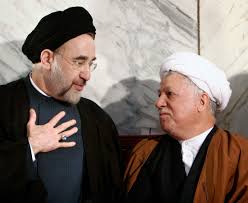London – The sudden death of Akbar Hashemi Rafsanjani, the most powerful man since the beginning of the current Iranian regime, has caused significant gap in the map of powers in Iran.
Despite all the rumors that surrounded Rafsanjani’s death, mainly about a meeting between Supreme Leader Ali Khamenei and Ahmadinejad to discuss the Rafsanjani’s successor in the chairmanship of the Expediency Discernment Council, this man’s death has left a remarkable deficiency in the Iranian regime.
The Expediency Discernment Council in Iran plays a critical consultative role, as its chairman serves in settling sharp disputes which usually occur between the government and the parliament. This position was one among others which served Hashemi Rafsanjani who was always seen as the most pragmatic man in the Guardianship of the Islamic Jurist. It is worth noting that this council was founded based on Rafsanjani’s suggestion to Ayatollah Khomeini.
The council didn’t enjoy a remarkable role when Rafsanjani was a president, however, when Mohammad Khatami reached presidency and Iran entered the so-called reform era for eight years, the council’s role saw an unprecedented development; it has undermined provisions of the government and the parliament that convoyed the reform plan at that time, and obliged Khatami and his followers to work according to some of the policies it imposed.
Predicted Measures
Rafsanhani passed away one month before the end of his fifth presidential term, and the Supreme Leader is expected to select 45 members for the council in March.
As per the successor of Rafsanjani, reports assert that Khamenei has selected Muhammad Ali Movahedi-Kermani (85 years), leader of the fundamentalist movement and secretary-general of Combatant Clergy Association. This man represented the supreme leader in 1990-2004 – according to Iranian media reports – Kermani has begun his mission until the election of new members.
Two scenarios are expected for the new council: the first is that Khamenei will renew the chairmanship of Kermani and the term of the majority of current members, while the other scenario is to shrink the council’s jurisdictions, so it becomes a consultative council for retired politicians.
Many observers suggest the adoption of the second scenario, as the council will never recapture its influence after Rafsanjani’s death – adding that it is the Supreme Leader’s best opportunity to avoid another Rafsanjani-like phenomenon.
The government and the parliament have called to weaken this council’s jurisdictions because it undermines theirs, which is another important indication to choose the second scenario.
“Reformists” and “Moderates Future ”
Concerns have dominated the followers of Reformists and Moderates camp, as Rafsanjani was among its most important figures after the divisions that emerged in this camp following the elections in 2005 and the ascension of the fundamentalist movement, the biggest profiteer from the chaos in the moderate party. The shift that took place in the moderate movement was also affected by the involvement of Rafsanjani who brought changes for the Moderates and the entire Iranian political scene.
How did this happen?
• Absence of leaders and field commanders opened the doors for Khatami, who was one of Rafsanjani’s ministers; Khatami sought to approach Rafsanjani and to establish the “Moderate Front”, which paved the road before the latter to be involved in the Moderate and reformist movement.
• Reformists were convinced that they should depend on Rafsanjani to protect them from Conservatives, as his presence in the authority will halt the liberty of Khamenei and his extremist followers.
• Rafsanjani’s followers and ministers supported Mohammad Khatami against the Conservative candidate in 1997, and heavily contributed in his victory.
• Rafsanjani aligned with Reformists aiming to recapture his influence after the election of Ahmadinejad for presidency and the support this latter received from Ali Khamenei.
• Based on the abovementioned, Rafsanjani succeeded in unifying the reformists and organizing their ranks, due to his pragmatism. However, this man left today, which raises many question marks of the future of the reformist scene.
Khatami’s Weaknesses
Khatami is unable to play Rafsanjani’s role for many reasons, including:
1. Khatami do not enjoy the support of all the reformist parties despite his wide popularity- experience proved that Khatami cannot unify ranks, as much as he can incite people, unlike Rafsanjani. Yet, in the near future, reformists need the regulative factor more than the popular factor.
2. The division in the reformist lines negatively affected Rouhani’s campaign in the elections.
3. As per leadership, Reformists will suffer from many problems.
4. Finally, Rafsanjani joined many poles under the reformist umbrella, and founded the so-called Moderate Movement, but Rafsanjani passed away.
